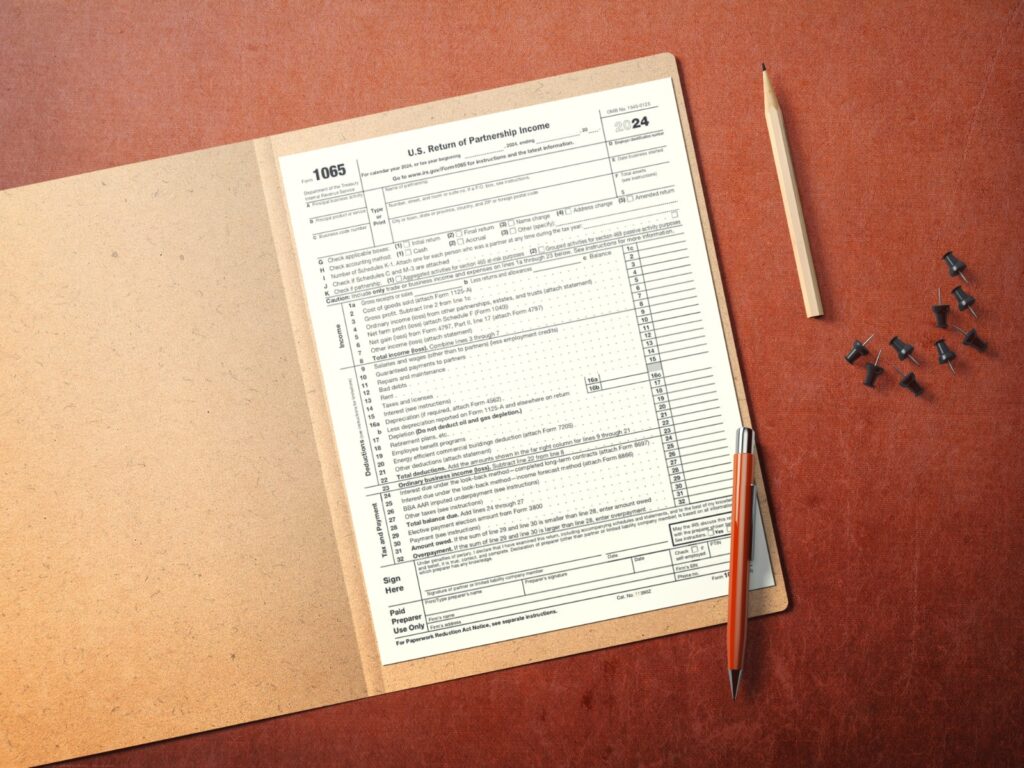Form 1065 is a federal tax return used by partnerships in the United States to report their annual financial activity to the Internal Revenue Service (IRS). Unlike corporations, partnerships are considered pass-through entities, which means the business itself does not pay federal income tax. Instead, profits and losses are passed through to the individual partners, who report them on their personal income tax returns.
This form is critical because it provides the IRS with a full summary of the partnership’s income, deductions, gains, and losses for the tax year. Additionally, each partner receives a Schedule K-1 that details their specific share of the partnership’s earnings or losses. Professional Tax services can help ensure Form 1065 is filed accurately and in compliance with IRS requirements.
Key Takeaways
- Form 1065 is the annual return that reports a partnership’s financial activity
- The form does not calculate a tax liability for the partnership but is required to inform the IRS about its operations
- Each partner must file their own taxes using the information from Schedule K-1
- Form 1065 must be submitted by March 15 if the partnership follows a calendar year
- Filing late can result in monthly penalties per partner
Who Must File Form 1065?
All domestic partnerships must file Form 1065, even if they had no income during the year. This includes general partnerships, limited partnerships, and limited liability companies (LLCs) that have elected to be taxed as partnerships. Any business entity with two or more partners operating with the intent to generate profit is considered a partnership for tax purposes.
In addition, certain foreign partnerships with income effectively connected to a U.S. trade or business may be required to file. However, those with under $20,000 in gross income or less than 1 percent U.S. source income may qualify for an exemption.
Nonprofit religious organizations that fall under section 501(d) are also required to file Form 1065. These entities must show how profits are distributed to their members, whether or not the distributions were actually made.
What Does Form 1065 Report?
Form 1065 reports the partnership’s total revenue, cost of goods sold, business expenses, and net profit or loss. It gives a complete overview of the business’s financial health during the tax year. The IRS uses this information to match income reported on each partner’s Schedule K-1 with what the business reports.
Partners then use their K-1 forms to complete their personal tax filings. It’s important to understand that even if a partner does not receive a distribution of profits, they are still taxed on their share of the income as reported on their K-1.
When and How to File Form 1065
Filing Deadline
Form 1065 must be filed by the 15th day of the third month after the end of the partnership’s tax year. For most partnerships using the calendar year, the deadline is March 15. If more time is needed, partnerships can file Form 7004 to request a six-month extension.
Required Information
Before completing Form 1065, you will need:
- Employer Identification Number (EIN)
- Business start date
- Total number of partners
- Profit and loss statement
- Balance sheet at beginning and end of year
You may also need supporting forms such as:
- Form 4562 for depreciation and amortization
- Form 1125-A for cost of goods sold
- Form 4797 for the sale of business property
- Form 114 for foreign bank accounts (if applicable)
- Form 3520 for certain foreign gifts or trust transactions
- Form 1099 copies issued by the business
Farming partnerships may also need to reference individual Form 1040 filings.
Additional Schedules
Depending on the size and structure of your business, you may need to include:
- Schedule L for the balance sheet
- Schedule M-1 for reconciliation of income
- Schedule M-2 for analysis of partners’ capital accounts
Schedule K-1 and Its Connection to Form 1065
Alongside Form 1065, the partnership must prepare Schedule K-1 for each partner. This document breaks down each partner’s share of income, losses, deductions, and credits. While Form 1065 gives a business-wide summary, the K-1 is personalized and must be submitted with each partner’s individual income tax return.
It is essential for partners to report everything from their K-1 forms on Schedule E of their personal return. Even if no money was distributed, tax on allocated income still applies.
What Happens If You File Late?
Missing the Form 1065 filing deadline can lead to serious penalties. As of the latest IRS guidelines, the penalty is $220 per month per partner for each month the return is late, up to a maximum of 12 months. These penalties apply even if the partnership had no income or activity during the year.
Do You Need to File Form 1065 If There Was No Income?
Even if your partnership earned no income during the year, you are still required to file Form 1065 if you had any expenses that could qualify as deductions or credits. The only exception is for dormant partnerships that had no financial activity whatsoever during the tax year.
What Is the Difference Between Form 1065 and Schedule K-1?
Form 1065 is the partnership’s return, while Schedule K-1 is the breakdown of financial data for each individual partner. The two documents work hand in hand. The IRS uses them to ensure that partners accurately report their share of the business’s earnings.
Need Help With Form 1065? Contact Mayatax Today
Preparing and filing Form 1065 correctly is essential for your partnership’s compliance and your partners’ tax obligations. Whether you’re a small business, startup, or nonprofit filing for the first time, Mayatax can help.
Our tax professionals will:
- Guide you through the filing process
- Prepare and submit Form 1065 accurately
- Generate Schedule K-1s for each partner
- Ensure compliance with IRS deadlines and rules
Have questions about Form 1065? Don’t risk penalties or IRS notices, contact The Madtax today and let us take care of it for you.

